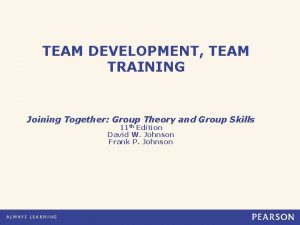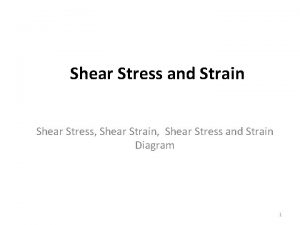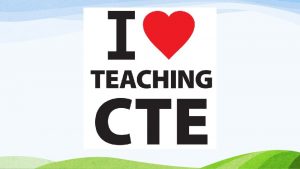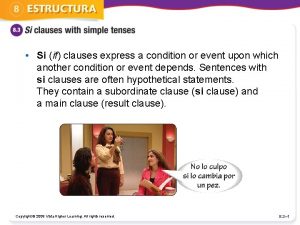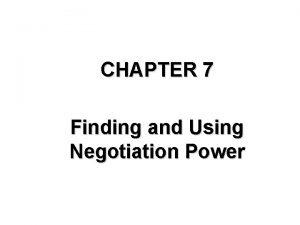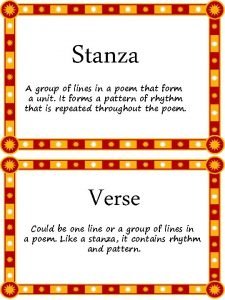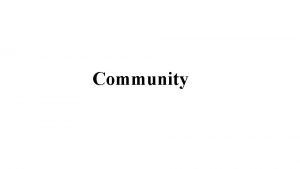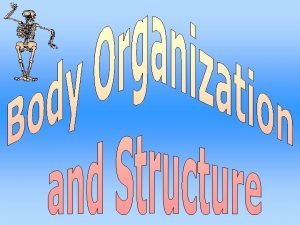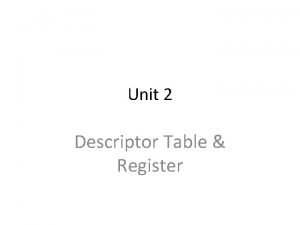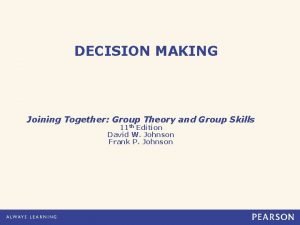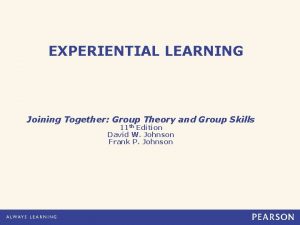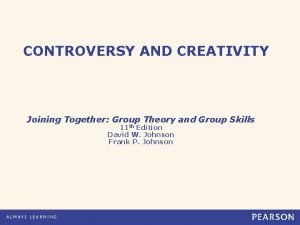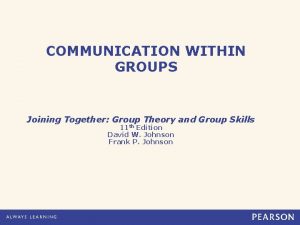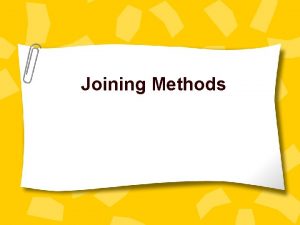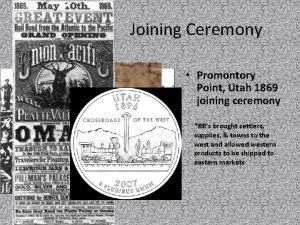USING POWER Joining Together Group Theory and Group


















- Slides: 18

USING POWER Joining Together: Group Theory and Group Skills 11 th Edition David W. Johnson Frank P. Johnson

Nature Of Power Constructive Vs. Destructive Uses Of Power Two Views Of Power: • Dynamic Interdependence View Of Power • Trait-Factor View Of Power Bases Of Power Unequal Power • High Power Members • Low Power Members Indirect Power: • Group Norms • Group Mind Johnson. Joining Together: Group Theory and Group Skills, 11 e. © 2013, 2009, 2006, 2003, 2000 by Pearson Education, Inc. All Rights Reserved 6 -2

Power: Capacity To Affect Outcomes Of Oneself, Others, Environment • Direct: In Interpersonal, Intergroup Interaction • Indirect: Through Group Norms, Values, Traditions Constructive Vs. Destructive Use Of Power: • Constructive: Increases Group Effectiveness, Benefits All Group Members, Encouraged By All Group Members • Destructive: Increases Self-Benefit, Forces Others To Do Something They Do Not Wish To Do Two Major Theories: • Dynamic-Interdependence: Who Influences Whom Changes Constantly As Individuals Strive To Achieve Mutual Goals • Trait Factor: Disposition To Exert Power Over Other People Johnson. Joining Together: Group Theory and Group Skills, 11 e. © 2013, 2009, 2006, 2003, 2000 by Pearson Education, Inc. All Rights Reserved 6 -3

What is Power? A quality of a person? Of a position? Of a place? Of a situation? Of a relationship? Can be constructive or destructive (enhances or interferes with the effectiveness of group work) Imposed on Others Invited by Others Benefits Self Most destructive Mislead, swindled, altruism Benefits Others Paternalism Most constructive Dominant view: power is negative and destructive. “Power tends to corrupt, and absolute power tends to corrupt absolutely” (Lord Acton) Dynamic-Interdependence View of Power: positive and essential for mutual enhancement Johnson. Joining Together: Group Theory and Group Skills, 11 e. © 2013, 2009, 2006, 2003, 2000 by Pearson Education, Inc. All Rights Reserved 6 -4

The Dynamic-Interdependence View of Power Who Influences Whom To What Degree Changes Constantly As Members Strive To Achieve The Group’s Goals. Power Exists In Relationships. Power Is: • Inevitable • Essential • Dynamic • Distributed Context Is Decisive • Competitive • Cooperative Johnson. Joining Together: Group Theory and Group Skills, 11 e. © 2013, 2009, 2006, 2003, 2000 by Pearson Education, Inc. All Rights Reserved 6 -5

Power in Competitive Context Defined as: successful influence that overcomes the other’s unwillingness to perform the desired behavior. Currently dominating approach among social scientists and power holders Power is viewed as: – A fixed-pie resource – A zero-sum resource – A commodity to be accumulated – Acting in a unidirectional way – Inherently coercive Limits other uses of power (based on trust and power sharing) Evokes reactance Johnson. Joining Together: Group Theory and Group Skills, 11 e. © 2013, 2009, 2006, 2003, 2000 by Pearson Education, Inc. All Rights Reserved 6 -6

Power in Cooperative Context Defined as: successful influence used to maximize joint benefits, and enhance the group’s effectiveness Power is viewed as – Expandable – To be shared – Acting in bidirectional way – Inherently noncoercive Largely ignored in the literature Research on people with cooperative cognitive orientation to power Inducibility Johnson. Joining Together: Group Theory and Group Skills, 11 e. © 2013, 2009, 2006, 2003, 2000 by Pearson Education, Inc. All Rights Reserved 6 -7

Mobilizing Power to Achieve Goals Determine your goals Determine your relevant resources Determine your needed coalitions Negotiate mutual support contracts Implement the contracts Johnson. Joining Together: Group Theory and Group Skills, 11 e. © 2013, 2009, 2006, 2003, 2000 by Pearson Education, Inc. All Rights Reserved 6 -8

The Trait-Factor Approach to Power Static Atomistic Historical Inductive Power and persuasion • Aristotle • Yale Attitude Change program, headed by Carl Hovland Social Dominance Theory Johnson. Joining Together: Group Theory and Group Skills, 11 e. © 2013, 2009, 2006, 2003, 2000 by Pearson Education, Inc. All Rights Reserved 6 -9

The Bases of Power Social exchange theory: power is based on the control of valuable resources. The type of resource basis for power (French & Raven, 1959) Reward power Coercive power Legitimate power Referent power Expert power Informational power Johnson. Joining Together: Group Theory and Group Skills, 11 e. © 2013, 2009, 2006, 2003, 2000 by Pearson Education, Inc. All Rights Reserved 6 -10

Power and Problem Solving Groups are more effective at solving problems when • Power is relatively balanced among its members • Power is based upon competence, expertise, and information Johnson. Joining Together: Group Theory and Group Skills, 11 e. © 2013, 2009, 2006, 2003, 2000 by Pearson Education, Inc. All Rights Reserved 6 -11

High Power Members Happy with the situation Hard to move toward cooperation, conciliation, and compromise Two strategies to keep the status quo: • Institute rules and norms to legitimize their power (“might-is-right”) • Deter low-power group members from rocking the boat by applying carrot and stick method (“if-only-you-would-behave-neither-of-us-would-gothrough-this-suffering”) The metamorphic effects of high power Status and power Power stereotyping theory Oppression Johnson. Joining Together: Group Theory and Group Skills, 11 e. © 2013, 2009, 2006, 2003, 2000 by Pearson Education, Inc. All Rights Reserved 6 -12

High Power Strategies To Justify Status Quo L = Legitimize Own Privileges And Intimidate Low-Power Individuals E = Self-Enhancement A = Attribute Low-Power People’s Success To Own Control D = Devalue Low-Power Individuals And Their Contributions Johnson. Joining Together: Group Theory and Group Skills, 11 e. © 2013, 2009, 2006, 2003, 2000 by Pearson Education, Inc. All Rights Reserved 6 -13

Low Power Members Build Coalitions Educate And Morally Persuade Bring High-Power Group Members To Negotiating Table: • Use Existing Legal Procedures To Pressure For Change • Use Obstruction Or Harassment To Increase High-Power Members’ Costs • Terrorism Metamorphic Effects Of Low-Power Relationships Among Low-Power Groups Revenge Johnson. Joining Together: Group Theory and Group Skills, 11 e. © 2013, 2009, 2006, 2003, 2000 by Pearson Education, Inc. All Rights Reserved 6 -14

Low-Power Strategies To Change Status Quo C = Cooperative, Compliant, Yielding To High. Power Members O = Attribution Of Causes Of Group Successes To Own Efforts R = Resistance, Psychological Reactance, Obstruction Of High-Power Members’ Efforts E = Negative Evaluations Of High-Power Members Johnson. Joining Together: Group Theory and Group Skills, 11 e. © 2013, 2009, 2006, 2003, 2000 by Pearson Education, Inc. All Rights Reserved 6 -15

Group Norms Conforming To Group Norms: • Conformity: Changes In Behavior Resulting From Group Influences • Compliance: Behavioral Change Without Internal Acceptance Implementing Group Norms Johnson. Joining Together: Group Theory and Group Skills, 11 e. © 2013, 2009, 2006, 2003, 2000 by Pearson Education, Inc. All Rights Reserved 6 -16

The Group Mind Collective Behavior: Spontaneously Perform Atypical Actions Such As Riots Or Mass Hysteria Group Mind: In Mob Individuals Act Impulsively Unreasonably, Extreme Ways • Anonymity: People Feel Less Responsible For Actions • Contagion: Emotion States Spreads From Person To Person Convergence Theory: People With Compatible Motivations Release Previously Controlled Behaviors Emergent Norm Theory: Heterogeneous Individuals Adhere To Current Norms Deindividuation: State Of Relative Anonymity, Members Do Not Feel Identifiable Johnson. Joining Together: Group Theory and Group Skills, 11 e. © 2013, 2009, 2006, 2003, 2000 by Pearson Education, Inc. All Rights Reserved 6 -17

Summary Power Dynamic Interdependence Approach Trait Factor Approach Bases Of Power Unequal Power • High-Power Members • Low-Power Members Indirect Use Of Power • Norms • Group Mind Johnson. Joining Together: Group Theory and Group Skills, 11 e. © 2013, 2009, 2006, 2003, 2000 by Pearson Education, Inc. All Rights Reserved 6 -18
 Joining together group theory and group skills
Joining together group theory and group skills Joining together as a team to improve the quality
Joining together as a team to improve the quality Draw the power triangle
Draw the power triangle Vragen
Vragen Shear stress definition
Shear stress definition Welcome thank you for joining us
Welcome thank you for joining us What is the joining of egg and sperm called
What is the joining of egg and sperm called What is a ctso and what are the benefits of joining
What is a ctso and what are the benefits of joining Welcome thank you for joining us
Welcome thank you for joining us Joining clauses with if and when
Joining clauses with if and when Mechanical fastening
Mechanical fastening Finding and using negotiation power
Finding and using negotiation power Whats a stanza in a poem
Whats a stanza in a poem People living in a community
People living in a community A group or chain of islands clustered together
A group or chain of islands clustered together Group of similar cells working together
Group of similar cells working together A large group of islands clustered together
A large group of islands clustered together Size of gdtr
Size of gdtr Cell to tissue to organ to organ system to organism
Cell to tissue to organ to organ system to organism

